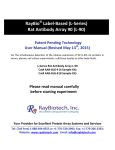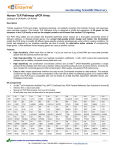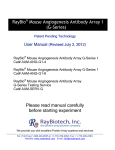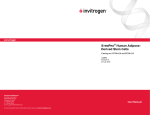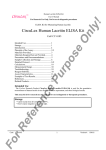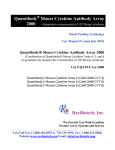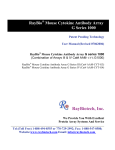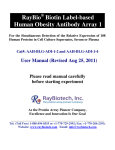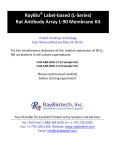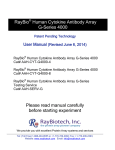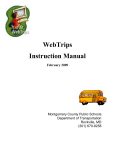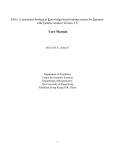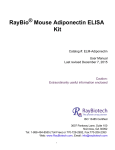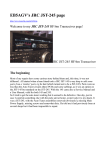Download Manual - RayBiotech, Inc.
Transcript
RayBio Label-Based (L-Series) Mouse Antibody Array 308 (L-308) Patent Pending Technology User Manual (Revised Jan 18, 2014) For the simultaneous detection of the relative expression of 308 (L-308) mouse proteins in serum, plasma, cell culture supernatants, cell/tissue lysates or other body fluids. L-Series Mouse Antibody Array L-308 Cat# AAM-BLG-1-2 (2 Sample Kit) Cat# AAM-BLG-1-4 (4 Sample Kit) Please read manual carefuly before starting experiment Your Provider for Excellent Protein Array Systems and Services Tel: (Toll Free) 1-888-494-8555 or +1-770-729-2992; Fax: +1-770-206-2393; Website: www.raybiotech.com Email: [email protected] RayBiotech, Inc TABLE OF CONTENTS Introduction and How It Works……...………...... Materials Provided………………………….…… A. Storage Recommendations…………….…….. B. Additional Materials Required………………. III. Overview and General Considerations…….……. A. Preparation and Storage of Samples…………. B. Handling the Glass Slides…….……….…..…. C. Glass Slide Layout…………….…………..…. D. Incubation and Washes………………………. IV. Protocol…………………………………………... A. Dialysis of Sample.…………………..……..... B. Biotin Labeling of Sample ………..…………. C. Drying of the Glass Chip.……………..…....... D. Blocking and Incubations…............................. E. Fluorescence Detection….…….……….…...... V. Antibody Array Map….…….……….................... VI. Interpretation of Results………………….……… VII. Troubleshooting Guide………………………...... VIII. Selected References……………...….…….......... I. II. RayBio® L-Series Mouse Antibody Array L-308 Protocol 2 3 3 4 4 4 7 8 8 9 9 10 12 12 16 18 20 24 25 1 I. Introduction Recent technological advances by RayBiotech have enabled the largest commercially available antibody array to date. With the L-Series Antibody Array 308, researchers can now obtain a broad, panoramic view of cytokine expression. The expression levels of 308 mouse target proteins can be simultaneously detected, including cytokines, chemokines, adipokine, growth factors, angiogenic factors, proteases, soluble receptors, soluble adhesion molecules and other proteins in cell culture supernatants, serum and plasma. The first step in using the RayBio® L-Series Mouse Antibody Array 308 is to biotinylate the primary amine of the proteins in serum or plasma samples, cell culture supernatant, cell lysate or tissue lysate. The glass slide arrays are then blocked, just like a Western blot, and the biotin-labeled sample is added onto the glass slide, which is pre-printed with capture antibodies, and incubated to allow for interaction of target proteins. Streptavidin-conjugated fluorescent dye (Cy3 equivalent) is then applied to the array. Finally, the glass slide is dried, and laser fluorescence scanning is used to visualize the signals. RayBio® L-Series Mouse Antibody Array L-308 Protocol 2 II. Materials Provided A. Storage Recommendations Upon receipt, the kit should be stored at -20°C until needed. Please use within 6 months from the date of shipment. After initial use, remaining reagents should be stored at 4°C to avoid repeated freeze-thaw cycles (may be stored for up to 3 months, Labeling Reagent, Item B should be fresh preparation before use). Unused glass slides should be kept at -20 °C and avoid repeated freezethaw cycles (may be stored for up to 6 months). RayBio® L-Series Mouse Antibody Array 308 ITEM A B D E F G H I J K L N/A M DESCRIPTION Dialysis Vials Labeling Reagent Stop Solution Cat#: AAM-BLG-1-2 Cat#: AAM-BLG-1-4 4 vials 1 vials 8 vials 2 vials ® RayBio L-series Human Antibody Array L-308 Glass Slides* Blocking Buffer 20X Wash Buffer I 20X Wash Buffer II Cy3-Conjugated Streptavidin** Adhesive Plastic Strips Labeling Buffer Floating Dialysis Rack 2X Cell Lysis Buffer*** 30 ml Centrifuge Tube 1 vial (50 μl) 1 L-308 Slide 2 L-308 Slides 1 bottle (8 ml) 1 bottle (30 ml) 1 bottle (30 ml) 1 vials 1 bottle (8 ml) 1 bottle (30 ml) 1 bottle (30 ml) 2 vials 1 bottlel (8 ml) 1 rack 1 bottle (10 ml) 1 tube *Each slide contains 2 identical subarrays **HiLyte PlusTM 532 ***Only needed if testing cell or tissue lysates RayBio® L-Series Mouse Antibody Array L-308 Protocol 3 B. Additional Materials Required Distilled or de-ionized water KCl, NaCl, KH2PO4 and Na2HPO4 Small plastic or glass containers Orbital shaker or oscillating rocker Beaker, stir plate and stir bar 1 ml tube Pipettors, pipette tips and other common lab consumables Laser scanner for fluorescence detection (list available online) Aluminum foil III. Overview and General Considerations A. Preparation and Storage of Samples 1) Preparation of Cell Culture Supernatants Seed cells at a density of 1x106 cells in 100 mm tissue culture dishes (*). ● Culture in complete culture medium for ~24–48 hours (**). ● Replenish with serum-free or low-serum medium such as 0.2% FCS/FBS serum, and then incubate cells again for ~48 hours (**, †). Recommended using membrane-based array if using high serum medium such as 10% FCS/FBS, the glass slide arrays tend to have extremely high background for high serum containing media samples. ● To collect supernatants, centrifuge at 1,000 g for 10 min and store as ≤1 ml aliquots at -80°C until needed. ● RayBio® L-Series Mouse Antibody Array L-308 Protocol 4 ● Measure the total wet weight of cultured cells in the pellet and/or culture dish. You may then normalize between arrays by dividing fluorescent signals by total cell mass (i.e., express results as the relative amount of protein expressed/mg total cell mass). Or you can normalize between array by determining cell lylate concentration using a total protein assay (BCA Protein Assay Kit, Pierce, Prod# 23227). Note: * The density of cells per dish used is dependent on the cell type. More or less cells may be required. ** Optimal culture time may vary and will depend on the cell line, treatment conditions and other factors. † Bovine serum proteins produce detectable signals on the RayBio® L-Series Mouse Antibody Array 308 in media containing serum concentrations as low as 0.2%. When testing serum-containing media, we strongly recommend testing an uncultured media blank for comparison with sample results. 2) Extracting Protein from Cells ● For attached cells, remove supernatant from cell culture, wash cells twice with cold 1X PBS. For suspension cells, pellet the cells by centrifuging using a microcentrifuge at 1500 rpm for 10 min. ● Make sure to remove any remaining PBS before adding 1X RayBio® L-Series Mouse Antibody Array L-308 Protocol 5 Cell Lysis Buffer (2X Cell Lysis Buffer should be diluted 2 fold with deionized or distilled water). Solubilize the cells at 2x107 cells/ml in 1X Cell Lysis Buffer. ● Pipette up and down to resuspend cells and rock the lysates gently at 2–8 °C for 30 minutes. Transfer extracts to microfugetubes and centrifuge at 13,000 rpm for 10 min at 2-8 °C *. ● Transfer supernatant to a clean tube. Determining cell lylate concentration using a total protein assay (BCA Protein Assay Kit, Pierce, Prod# 23227). Aliquot the lysates and store at – 70°C. Note *: If the supernatant appears to be cloudy, transfer the supernatants to a clean tube, centrifuge again at 13,000 rpm for 20 minutes at 2-8°C. If the supernatant is still not clear, store the lysate at -70°C for 20 minutes. Remove from the freezer, immediately centrifuge at 13,000 rpm for 20 minutes at 2-8°C. 3) Extracting Protein from Crude Tissue ● Transfer approximate 100 mg crude tissue into a tube with 1 ml 1X Cell Lysis Buffer (2X Cell Lysis Buffer should be diluted 2 fold with deionized or distilled water). ● Homogenize the tissue according to homogenizer manufacturer instructions. ● Transfer extracts to microcentrifuge tubes and centrifuge for 20 min at 13,000 rpm (4°C). ● Transfer supernatant to a clean tube and store at – 70°C. Note *: If the supernatant appears to be cloudy, transfer the RayBio® L-Series Mouse Antibody Array L-308 Protocol 6 supernatants to a clean tube, centrifuge again at 13,000 rpm for 20 minutes at 2-8°C. If the supernatant is still not clear, store the lysate at -70°C for 20 minutes. Remove from the freezer, immediately centrifuge at 13,000 rpm for 20 minutes at 2-8°C. B. Handling the glass slides The microarray slides are delicate. Please do not touch the array surface with pipette tips, forceps or your fingers. Hold the slides by the edges only. Handle the slides with powder-free gloves and in a clean environment. Do not remove the glass slide from the chamber assembly until step 19, and take great care not to break the glass slide when doing so. Remove reagents/sample by gently applying suction with a pipette to corners of each chamber. Do not touch the printed area of the array, only the sides. RayBio® L-Series Mouse Antibody Array L-308 Protocol 7 C. Layout of Mouse L-308 Glass Slide Two identical sub-arrays on one slide D. Incubations and Washes Cover incubation chamber with a Plastic Adhesive Strip (Item J) to prevent evaporation during incubation or wash steps, particularly those lasting 2 hours or longer. During incubation and wash steps avoid foaming and be sure to remove all bubbles from the sub-array surface. Perform all incubation and wash steps under gentle rotation or rocking motion (~0.5 to 1 cycle/sec). Wash steps in Wash Buffer II and all incubation steps may be performed overnight at 4°C. Avoid cross-contamination of samples to neighboring wells. To remove Wash Buffers and other reagents from chamber wells, you may invert the Glass Slide Assembly to decant, and aspirate the remaining liquid. Unlike most Cy3 fluors, the HiLyte Plus™ 532 used in this kit is very stable at RT and resistant to photobleaching on the hybridized glass slides. However, please protect glass slides from directly strong light and temperatures above RT. RayBio® L-Series Mouse Antibody Array L-308 Protocol 8 IV. Protocol Assay Diagram 1. Cell culture supernatants or cell/tissue lysates*. 2. Serum or plasma * If using cell or tissue lysates start at step 2. “Dialysis of sample” A. Dialysis of Sample Note: Samples must be dialyzed prior to biotin-labeling (Steps 5–7). 1. To prepare dialysis buffer (1X PBS, pH=8.0), dissolve 0.6 g KCl, 24 g NaCl, 0.6 g KH2PO4 and 3.45 g Na2HPO4 in 2500 ml deionized or distilled water. Adjust pH=8.0 with 1M NaOH and adjust final volume to 3000 ml with de-ionized or distilled water. RayBio® L-Series Mouse Antibody Array L-308 Protocol 9 2. Add each sample into a separate Dialysis Tube (Item A). Load 200 μl cell culture supernatant or 100 μl cell lysates or tissue lysate (1~2 mg/ml total protein) or 20 μl serum or plasma + 80 μl 1X PBS, pH=8 (5-fold dilution. Carefully place Dialysis Tubes into Floating Dialysis Rack (Item L). 3. Place Floating Dialysis Rack into ≥500 ml dialysis buffer in a large beaker. Place beaker on a stir plate and dialyze, for at least 3 hours at 4°C, stirring buffer gently. Then exchange the 1X PBS buffer and repeat dialysis for at least 3 h at 4°C. Transfer dialyzed sample to a clean eppendorf tube. Spin dialyzed samples for 5 min at 10,000 rpm to remove any particulates or precipitants, and then transfer the supernatants to a clean tube. Note: The sample volume may change during dialysis. Note: Dialysis procedure may proceed overnight. Note: Determine the total protein concentration for cell culture supernatants or cell/tissue lysate after dialysis procedure (Step 3). We recommended using a BCA total protein assay (eg, Pierce, Catalog # 23227). B. Biotin-labeling Sample Note: Amines (e.g., Tris, glycine) and azides quench the biotinylation reaction. Avoid contaminating samples with these chemicals prior to biotinylation. RayBio® L-Series Mouse Antibody Array L-308 Protocol 10 4. Immediately before use, prepare 1X Labeling Reagent. Briefly spin down the Labeling Reagent tube (Item B). Add 100 µl 1X PBS into the tube, pipette up and down or vortex slightly to dissolve the lyophilized reagent. 5. Add 1X Labeling Reagent to dialyzed samples. a) For labeling cell culture supernatants: transfer 180 μl dialyzed sample into a new tube. Add 36 μl of 1X Labeling Reagent Solution per 1 mg total protein in dialyzed cell culture supernatant. Mix well. For example, if sample’s total protein concentration is 0.5 mg/ml you need to add 3.24 µl 1X Labeling Reagent to 180 μl dialyzed sample. b) For labeling serum or plasma: Add 22 μl of 1X Labeling Reagent Solution into a new tube containing 35 μl* dialyzed serum or plasma sample and 155 μl Labeling Buffer (Item K). *Note: To normalize serum/plasma concentrations during biotinylation, measure sample volume before and after dialysis. Then adjust the volumes of dialyzed serum/plasma and Labeling Buffer to compensate (to keep same total protein amount and total volume). For example, if serum/plasma sample volume increased from 100 μl to 200 μl, add 70 μl dialyzed serum and 120 μl Labeling Buffer to keep same total volume, 212 ul. c) For labeling cell or tissue lysates: transfer 30 µg (15 μl of 2 mg/ml) cell or tissue lysates into a tube and add labeling RayBio® L-Series Mouse Antibody Array L-308 Protocol 11 buffer (Item K) for a total volume of 300 μl. Then add 3.3 μl of 1X Labeling Reagent Solution. 6. Incubate the reaction solution at room temperature with gentle rocking or shaking for 30 min. Mix the reaction solution by gently tapping the tube every 5 min. 7. Add 3 μl Stop Solution (Item D) into each reaction tube and immediately dialyze as directed in Steps 2–3. Note: Biotinylated samples can be stored at -20°C or -80°C until you are ready to proceed with the assay. C. Drying of the Glass Slide 8. Remove the package containing the Assembled Glass Slide (Item E) from the freezer. Place unopened package on the bench top for approx. 15 min, and allow the Assembled Glass Slide to equilibrate to room temperature (RT). 9. Open package, and take the Assembled Glass Slide out of the sleeve (Do not disassemble the Glass Slide from the chamber assembly). Place glass slide assembly in laminar flow hood or similar clean environment for 1-2 hours at RT. Note: Protect the slide from dust or others contaminants. D. Blocking and Incubations Note: Glass slide should be completely dry before adding Blocking Buffer to wells. RayBio® L-Series Mouse Antibody Array L-308 Protocol 12 10. Block sub-arrays by adding 400 μl of Blocking Buffer (Item F) into each well of Assembled Glass Slide and incubating at RT for 30 min. Ensure there are no bubbles on the array surfaces. 11. Immediately prior to sample incubation, spin biotin-labeled samples for 5 min at 10,000 rpm to remove any particulates or precipitants. Dilute samples with Blocking Buffer.* *Note: Recommended dilution of the biotin-labeled samples with Blocking Buffer prior to incubation is 2-10 fold for cell culture supernatants, 20-fold for serum/plasma or 30 fold cell/tissue lysate . Note: Optimal sample dilution factor will depend on the abundance of target proteins. If the background or antigen-specific antibody signals are too strong, the sample can be diluted further in subsequent experiments. If the signal is too weak, more concentrated samples can be used. 12. Completely remove Blocking Buffer from each well. Add 400 μl of diluted samples into appropriate wells. Remove any bubbles on array surfaces. Incubate arrays with gentle rocking or shaking for 2 hours at RT or overnight at 4°C. Note: Avoid the flow of sample into neighboring wells. 13. Dilute 20X Wash Buffer I Concentrate (Item G) 20-fold with de-ionized or distilled water. Decant the samples from each RayBio® L-Series Mouse Antibody Array L-308 Protocol 13 well, and wash 3 times with 800 μl of 1X Wash Buffer I at RT with gentle rocking or shaking for 5 min per wash. 14. Obtain a clean container (e.g., pipette tip box or slidestaining jar), place the Assembled Glass Slide into the container with enough volume of 1X Wash Buffer I to completely cover the entire assembly, and remove any bubbles in wells. Wash 2 times at RT with gentle rocking or shaking for 10 min per wash. 15. Dilute 20X Wash Buffer II Concentrate (Item H) 20-fold with de-ionized or distilled water. Decant the Wash Buffer I from each well, place the Assembled Glass Slide into the container with enough volume of 1X Wash Buffer II to completely cover the entire assembly, and remove any bubbles in wells. Wash 2 times at RT with gentle rocking or shaking for 5 min per wash. 16. Prepare 1X Cy3-Conjugated Streptavidin: a) Briefly spin down tube containing the Cy3-Conjugated Streptavidin (Item I) immediately before use. b) Add 1000 μl of Blocking Buffer into the tube to prepare a concentrated Cy3-Conjugated Streptavidin stock solution. Pipette up and down to mix gently (do not store the stock solution for later use). c) Add 200 μl of Cy3-Conjugated Streptavidin stock solution into a tube with 800 μl of Blocking Buffer. Mix gently to prepare 1X Cy3-Conjugated Streptavidin. RayBio® L-Series Mouse Antibody Array L-308 Protocol 14 17. Carefully remove Assembled Glass Slide from container. Remove all of Wash Buffer II from the wells. Add 400 μl of 1X Cy3-Conjugated Streptavidin to each sub-array. Cover the incubation chamber with the plastic adhesive strips. Note: Avoid exposure to light in Steps 19–25 by covering the Glass Slide Assembly with aluminum foil or incubate in dark room. 18. Incubate with Cy3-Conjugated Streptavidin at RT for 2 hours with gentle rocking or shaking. Note: Incubation may be done overnight at 4°C. 19. Decant the solution and disassemble the glass slide from the incubation frame and chamber. Disassemble the device by pushing clips outward from the side, as shown below. Carefully remove the glass slide from the gasket. Note: Be careful not to touch the printed surface of the glass slide, which is on the same side as the barcode. 20. Gently place the glass slide into 30 ml Centrifuge Tube (Item M). Add enough 1X Wash Buffer I to cover the entire glass slide. Wash with gentle rocking or shaking for 10 min. Remove the wash buffer. Repeat 2 times for a total of 3 washes. 21. Repeat step 20, this time with 1X Wash Buffer II. Repeat one time for a total of two washes for 5 min per wash. RayBio® L-Series Mouse Antibody Array L-308 Protocol 15 22. Finally, wash the glass slide with 30 ml of de-ionized or distilled water for 5 min. Remove glass slide and decant water from Centrifuge Tube. 23. Remove excess liquid from Centrifuge Tube, and place glass slide into the tube. Centrifuge at 1,000 rpm for 3 minutes to remove water droplets. Make sure the finished glass slide is completely dry before scanning or storage. Note: Alternatively, you may gently dry the glass slide using a low-velocity Nitrogen gas stream or ambiently in a laminar flow hood or similar clean environment (Be sure to protect from light). E. Fluorescence Detection 24. You may proceed immediately to scanning or you may store the slide at -20 °C in the Centrifuge Tube provided or at RT and to scan at a later time. Note: Unlike most Cy3 fluors, the HiLyte Plus™ Fluor 532 used in this kit is very stable at RT and resistant to photobleaching on completed glass slides. However, please protect glass slides from temperatures above RT and store them in the dark. Do not expose glass slide to strong light, such as sunlight or UV lamp. Note: If you need to repeat any of the incubation after finishing the experiment, you must first re-assemble the glass slide RayBio® L-Series Mouse Antibody Array L-308 Protocol 16 into the incubation chamber by following step as shown in the figures below. To avoid breaking the printed glass slide, you may first want to practice assembling the device with a blank glass slide. 1. Apply slide to incubation chamber barcode facing upward as in image A (below). 2. Gently snap one edge of a snap-on side as shown in image B. 3. Gently press other of side against lab bench and push in lengthwise direction (image C). 4. Repeat with the other side (image D) A B C D RayBio® L-Series Mouse Antibody Array L-308 Protocol 17 V. Antibody Array Map A. RayBio® L-series Mouse Antibody Array L-308 Map 1 2 3 4 5 6 7 8 9 10 11 12 13 14 15 16 17 18 19 20 21 22 23 1 2 3 4 5 6 7 8 9 10 11 12 13 14 15 16 17 18 19 20 21 22 23 24 25 26 27 28 P-1a P-1a P-2a P-2a P-3a P-3a Neg Neg 5 5 6 6 7 7 8 8 9 9 10 10 11 11 12 12 13 13 14 14 15 15 16 16 17 17 18 18 19 19 20 20 21 21 22 22 23 23 24 24 25 25 26 26 27 27 28 28 29 29 30 30 31 31 32 32 33 33 34 34 35 35 36 36 37 37 38 38 39 39 40 40 41 41 42 42 43 43 44 44 45 45 46 46 47 47 48 48 49 49 50 50 51 51 52 52 53 53 54 54 55 55 56 56 57 57 58 58 59 59 60 60 61 61 62 62 63 63 64 64 65 65 66 66 67 67 68 68 69 69 70 70 71 71 72 72 73 73 74 74 75 75 76 76 77 77 78 78 79 79 80 80 81 81 82 82 83 83 84 84 85 85 86 86 87 87 88 88 89 89 90 90 91 91 92 92 93 93 94 94 95 95 96 96 97 97 98 98 99 99 100 100 101 101 102 102 103 103 104 104 105 105 106 106 107 107 108 108 109 109 110 110 111 111 112 112 113 113 114 114 115 115 116 116 117 117 118 118 119 119 120 120 121 121 122 122 123 123 124 124 125 125 126 126 127 127 128 128 129 129 130 130 131 131 132 132 133 133 134 134 135 135 136 136 137 137 138 138 139 139 140 140 141 141 142 142 143 143 144 144 145 145 146 146 147 147 148 148 149 149 150 150 151 151 152 152 153 153 154 154 P-1b P-1b P-2b P-2b P-3b P-3b Neg Neg 159 159 160 160 161 161 162 162 163 163 164 164 165 165 166 166 167 167 168 168 169 169 170 170 171 171 172 172 173 173 174 174 175 175 176 176 177 177 178 178 179 179 180 180 181 181 182 182 183 183 184 184 185 185 186 186 187 187 188 188 189 189 190 190 191 191 192 192 193 193 194 194 195 195 196 196 197 197 198 198 199 199 200 200 201 201 202 202 203 203 204 204 205 205 206 206 207 207 208 208 209 209 210 210 211 211 212 212 213 213 214 214 215 215 216 216 217 217 218 218 219 219 220 220 221 221 222 222 223 223 224 224 225 225 226 226 227 227 228 228 229 229 230 230 231 231 232 232 233 233 234 234 235 235 236 236 237 237 238 238 239 239 240 240 241 241 242 242 243 243 244 244 245 245 246 246 247 247 248 248 249 249 250 250 251 251 252 252 253 253 254 254 255 255 256 256 257 257 258 258 259 259 260 260 261 261 262 262 263 263 264 264 265 265 266 266 267 267 268 268 269 269 270 270 271 271 272 272 273 273 274 274 275 275 276 276 277 277 278 278 279 279 280 280 281 281 282 282 283 283 284 284 285 285 286 286 287 287 288 288 289 289 290 290 291 291 292 292 293 293 294 294 295 295 296 296 297 297 298 298 299 299 300 300 301 301 302 302 303 303 304 304 305 305 306 306 307 307 308 308 309 309 310 310 311 311 312 312 313 313 314 314 315 315 316 316 Neg Neg Neg Neg Neg Neg P-3c P-3c P-2c P-2c P-1c P-1c RayBio® L-Series Mouse Antibody Array L-308 Protocol 18 RayBio® L-series Mouse Antibody Array L-308 List Number Name Number Name Number Name Number Name Number Name Number Name 1 Positive 1a 57 CXCL16 113 Granzyme D 169 IL-12 R beta 1 225 MIP-2 281 TIMP-2 2 Positive 2a 58 CXCR2 / IL-8 RB 114 Granzyme G 170 IL-13 226 MIP-3 alpha 282 TIMP-4 3 Positive 3a 59 CXCR3 115 Gremlin 171 IL-13 R alpha 2 227 MIP-3 beta 283 TL1A / TNFSF15 4 neg 60 CXCR4 116 Growth Hormone R 172 IL-15 228 MMP-2 284 TLR1 5 6Ckine 61 CXCR6 117 HGF R 173 IL-15 R alpha 229 MMP-3 285 TLR2 6 Activin A 62 DAN 118 HGF 174 IL-16 230 MMP-9 286 7 Activin C 63 Decorin 119 HVEM / TNFRSF14 175 IL-17 231 MMP-12 287 TLR4 8 Activin RIB / ALK-4 64 DKK-1 120 ICAM-1 176 IL-17BR 232 MMP-14 / LEM-2 288 TMEFF1 / Tomoregulin-1 TNF RI / TNFRSF1A TLR3 9 Adiponectin / Acrp30 65 Dkk-3 121 ICAM-2 / CD102 177 IL-17C 233 MMP-24 / MT5-MMP 289 10 AgRP 66 Dkk-4 122 ICAM-5 178 IL-17D 234 Neuregulin-3 / NRG3 290 TNF RII 11 ALCAM 67 DPPIV / CD26 123 ICK 179 IL-17E 235 Neurturin 291 TNF-alpha 12 Angiopoietin-like 2 68 DR3 / TNFRSF25 124 IFN-alpha / beta R1 180 IL-17F 236 NGF R / TNFRSF16 292 TNF-beta / TNFSF1B 13 Angiopoietin-like 3 69 Dtk 125 IFN-alpha / beta R2 181 IL-17R 237 NOV / CCN3 293 TPO 14 AR (Amphiregulin) 70 EDAR 126 IFN-beta 182 IL-17RC 238 Osteoactivin / GPNMB 294 TRAIL / TNFSF10 15 Artemin 71 EGF R 127 IFN-gamma 183 IL-17RD 239 Osteopontin 295 TRAIL R2 / TNFRSF10B 16 Axl 72 EG-VEGF / PK1 128 IFN-gamma R1 184 IL-18 R alpha/IL-1 R5 240 Osteoporotegerin 296 TRANCE / TNFSF11 17 b FGF 73 Endocan 129 IGFBP-1 185 IL-20 241 OX40 Ligand / TNFSF4 297 TREM-1 18 B7-1/CD80 74 Endoglin / CD105 130 IGFBP-2 186 IL-20 R alpha 242 PDGF C 298 TROY 19 BAFF R / TNFRSF13C 75 Endostatin 131 IGFBP-3 187 IL-21 243 PDGF R alpha 299 TSLP 20 BCMA / TNFRSF17 76 Eotaxin 132 IGFBP-5 188 IL-21 R 244 PDGF R beta 300 TSLP R 21 beta-Catenin 77 Eotaxin-2 133 IGFBP-6 189 IL-22 245 Pentraxin3 / TSG-14 301 TWEAK / TNFSF12 22 BLC 78 Epigen 134 IGFBP-rp1 / IGFBP-7 190 IL-22BP 246 PF-4 302 TWEAK R / TNFRSF12 23 BTC (Betacellulin) 79 Epiregulin 135 IGF-I 191 IL-23 247 PlGF-2 303 24 Cardiotrophin-1 80 Erythropoietin (EPO) 136 IGF-II 192 IL-23 R 248 Progranulin 304 uPAR 25 CCL1 / I-309 / TCA-3 81 E-Selectin 137 IL-1 alpha 193 IL-24 249 Prolactin 305 Urokinase 26 CCL28 82 FADD 138 IL-1 beta 194 IL-27 250 P-Selectin 306 VCAM-1 27 CCL4 / MIP-1 beta 83 FAM3B 139 IL-1 R4 / ST2 195 IL-28 / IFN-lambda 251 RAGE 307 VE-Cadherin 28 CCL7 / MCP-3 / MARC 84 Fas / TNFRSF6 140 IL-1 R6 / IL-1 R rp2 196 IL-31 252 RANTES 308 VEGF 29 CCL8 / MCP-2 85 Fas Ligand 141 IL-1 R9 197 IL-31 RA 253 RELM beta 309 VEGF R1 30 CCR10 86 FCrRIIB / CD32b 142 IL-1 RI 198 Insulin 254 Resistin 310 VEGF R2 31 CCR3 87 FGF R3 143 IL-1 RII 199 Integrin beta 2 / CD18 255 S100A10 311 VEGF R3 32 CCR4 88 FGF R4 144 IL-2 200 I-TAC 256 SCF 312 33 CCR6 89 FGF R5 beta 145 IL-2 R alpha 201 KC 257 SCF R / c-kit 313 VEGFC 34 CCR7 90 FGF-21 146 IL-2 R beta 202 Kremen-1 258 SDF-1 314 VEGF-D 35 CCR9 91 Fit-3 Ligand 147 IL-3 203 Kremen-2 259 Serum Amyloid A1 315 WIF-1 36 CD11b 92 FLRG (Follistatin) 148 IL-3 R alpha 204 Lefty-1 260 Shh-N 316 WISP-1 / CCN4 37 CD14 93 Follistatin-like 1 149 IL-3 R beta 205 Leptin R 261 SIGIRR 317 Neg 38 CRP 94 Fractalkine 150 IL-4 206 LEPTIN(OB) 262 SLPI 318 Neg 39 CD27 / TNFRSF7 95 Frizzled-1 151 IL-4 R 207 LIF 263 Soggy-1 319 Neg 40 CD27 Ligand / TNFSF7 96 Frizzled-6 152 IL-5 208 LIGHT / TNFSF14 264 SPARC 320 Positive 3c 41 CD30 97 Frizzled-7 153 IL-5 R alpha 209 LIX 265 Spinesin Ectodomain 321 Positive 2c 42 CD30 L 98 Galectin-3 154 IL-6 210 LRP-6 266 TACI / TNFRSF13B 322 Positive 1c 43 CD40 99 G-CSF 155 Positive 1b 211 L-Selectin 267 TARC 323 44 CD40 Ligand / TNFSF5 100 GDF-1 156 Positive 2b 212 Lungkine 268 TCA-3 324 45 Cerberus 1 101 GDF-3 157 Positive 3b 213 Lymphotactin 269 TCCR / WSX-1 325 46 Chordin-Like 2 102 GDF-5 158 neg 214 Lymphotoxin beta R / TNFRSF3 270 TECK 326 47 Coagulation Factor III / Tissue Factor 103 GDF-8 159 IL-6 R 215 MAdCAM-1 271 TFPI 327 48 Common gamma Chain / IL-2 R gamma 104 GDF-9 160 IL-7 216 MCP-1 272 TGF-beta 1 328 49 CRG-2 105 GFR alpha-2 / GDNF R alpha-2 161 IL-7 R alpha 217 MCP-5 273 TGF-beta 2 329 50 Cripto 106 GFR alpha-3 / GDNF R alpha-3 162 IL-9 218 M-CSF 274 TGF-beta 3 330 51 Crossveinless-2 107 GFR alpha-4 / GDNF R alpha-4 163 IL-9 R 219 MDC 275 TGF-beta RI / ALK-5 331 52 Cryptic 108 GITR 164 IL-10 220 MFG-E8 276 TGF-beta RII 332 53 Csk 109 GITR Ligand / TNFSF18 165 IL-10 R alpha 221 MFRP 277 Thrombospondin 333 54 CTACK 110 Glut2 166 IL-11 222 MIG 278 Thymus Chemokine-1 334 55 CTLA-4 / CD152 111 GM-CSF 167 IL-12 p40/p70 223 MIP-1 alpha 279 Tie-2 335 56 CXCL14 / BRAK 112 Granzyme B 168 IL-12 p70 224 MIP-1 gamma 280 TIMP-1 336 RayBio® L-Series Mouse Antibody Array L-308 Protocol Ubiqultin VEGF-B 19 VI. Interpretation of Results: A. Explanation of Controls Spots 1) Positive Control spots (POS1, POS2, POS3) are standardized amounts of biotinylated IgGs printed directly onto the array. All other variables being equal, the Positive Control intensities will be the same for each sub-array. This allows for normalization based upon the relative fluorescence signal responses to a known control, much as “housekeeping” genes or proteins are used to normalize results in PCR or Western blots, respectively. 2) Negative Control (NEG) spots contain a proteincontaining buffer (used to dilute antibodies printed on the array). Their signal intensities represent non-specific binding of Biotin-conjugated anti-Cytokines and/or the Cy3-Conjugated Streptavidin. Negative control signal intensities are usually very close to background signals in each sub-array. B. Typical results obtained with RayBio® L-Series Mouse Antibody Array L-308 The following figure shows the RayBio® L-Series Mouse Antibody Array 308 probed with serum sample. The images were captured using a Axon GenePix laser scanner. The strong signals in row 20 and the upper left and lower right corners of each RayBio® L-Series Mouse Antibody Array L-308 Protocol 20 array are Positive Controls, which can be used to identify the orientation and help normalize the results between arrays. RayBio® L-Series Mouse Antibody Array 308 Sample-1 Sample-2 If scanned using optimal settings, 3 distinct signal intensities will be seen: POS1>POS2>POS3. If all of these signals are of similar intensity, try increasing or decreasing laser power and/or signal gain settings. Also, in the absence of an external standard curve for each protein detected, there is no means of assessing absolute or relative concentrations of different proteins in the same sample using immunoassays. If you wish to obtain quantitative data (ie, concentrations of the various analytes in your samples), try using our Quantibody® Arrays instead. RayBio® L-Series Mouse Antibody Array L-308 Protocol 21 C. Background Subtraction: Once you have obtained fluorescence intensity data, you should subtract the background and normalize to the Positive Control signals before proceeding to analysis. Most laser fluorescence scanner software have an option to automatically measure the local background around each spot. For best results, we recommend comparing signal intensities representing the MEDIAN background signals minus local background. If your resulting fluorescence signal intensity reports do not include these values (e.g., a column labeled as “MED532B532”), you may need to subtract the background manually or change the default settings on your scanner’s data report menu. D. Normalization of Array Data: To normalize signal intensity data, one sub-array is defined as "reference" to which the other arrays are normalized. This choice is arbitrary. For example, in our Analysis Tool Software (described below), the array represented by data entered in the left-most column each worksheet is the default “reference array.” You can calculate the normalized values as follows: X(Ny) = X(y) * P1/P(y) Where: P1 = mean signal intensity of POS spots on reference array RayBio® L-Series Mouse Antibody Array L-308 Protocol 22 P(y) = mean signal intensity of POS spots on Array "y" X(y) = mean signal intensity for spot "X" on Array "y" X(Ny) = normalized signal intensity for spot "X" on Array "y" The RayBio® Analysis Tool software is available for use with data obtained using RayBio® Biotin Label-based Antibody Arrays. You can copy and paste your signal intensity data (with and without background) into the Analysis Tool, and it will automatically normalize signal intensities to the Positive Controls. To order the Analysis Tool, please contact us at +1-770-729-2992 or [email protected] for more information. E. Threshold of significant difference in expression: After subtracting background signals and normalization to Positive Controls, comparison of signal intensities between and among array images can be used to determine relative differences in expression levels of each protein between samples or groups. Any ≥1.5-fold increase or ≤0.65-fold decrease in signal intensity for a single analyte between samples or groups may be considered a measurable and significant difference in expression, provided that both sets of signals are well above background (Mean background + 2 standard deviations, accuracy ≈ 95%). RayBio® L-Series Mouse Antibody Array L-308 Protocol 23 VII. Troubleshooting Guide Problem Weak signal High background Uneven signal Cause Recommendation Inadequate detection Check laser power and PMT parameters Inadequate reagent volumes or improper dilution Check pipettors and ensure correct preparation Short incubation times Ensure sufficient incubation time and change sample incubation step to overnight Too low protein concentration in sample Don’t make too low dilution Or concentrate sample Improper storage of kit Store kit at suggested temperature Sample is too concentrated Use more diluted sample Excess of streptavidin Make sure to use the correct amount of streptavidin Inadequate detection Check laser power and PMT parameters Inadequate wash Increase the volume of wash buffer and incubation time Bubbles formed during incubation Avo id bubble formation during incubation and incubation time buffer volume Completely cover arrays with solution Arrays are not completely covered by reagent RayBio® L-Series Mouse Antibody Array L-308 Protocol 24 VIII. Selected References 1. Christina Scheel et all. Paracrine and Autocrine Signals Induce and Maintain Mesenchymal and Stem Cell States in the Breast. Cell. 2011;145, 926–940 2. Lin Y, Huang R, Chen L, et al. Profiling of cytokine expression by biotin-labeled-based protein arrays. Proteomics. 2003, 3: 1750–1757. 3. Huang R, Jiang W, Yang J, et al. A Biotin Label-based Antibody Array for High-content Profiling of Protein Expression. Cancer Genomics Proteomics. 2010; 7(3):129– 141. 4. Liu T, Xue R, Dong L, et al. Rapid determination of serological cytokine biomarkers for hepatitis B–virus-related hepatocellulare carcinoma using antibody arrays. Acta Biochim Biophys Sin. 2011; 43(1):45–51. 5. Cui J, Chen Y, Chou W-C, et al. An integrated transcriptomic and computational analysis for biomarker identification in gastric cancer. Nucl Acids Res. 2011; 39(4):1197–1207. 6. Jun Zhong et all. Temporal Profiling of the Secretome during Adipogenesis in Humans. Journal of Proteome Research. 2010, 9, 5228–5238 7. Chowdury UR, Madden BJ, Charlesworth MC, Fautsch MP. Proteomic Analysis of Human Aqueous Humor. Invest Ophthalmol Visual Sci. 2010; 51(10):4921–4931. RayBio® L-Series Mouse Antibody Array L-308 Protocol 25 8. Wei Y, Cui C, Lainscak M, et al. Type-specific dysregulation of matrix metalloproteinases and their tissue inhibitors in endstag heart failure patients: relationshp between MMP-10 and LV remodeling. J Cell Mol Med. 2011; 15(4):773–782. 9. Kuranda K, Berthon C, Lepêtre F, et al. Expression of CD34 in hematopoietic cancer cell lines reflects tightly regulated stem/progenitor-like state. J Cell Biochem. 2011; 112(5):1277– 1285. 10. Toh HC, Wang W-W, Chia WK, et al. Clinical Benefit of Allogenic Melanoma Cell Lysate-Pulsed Autologous Dendritic Cell Vaccine in MAGE-Positive Colorectal Cancer Patients. Clin Chem Res. 2009; 15:7726–7736. 11. Zhen Hou. Cytokine array analysis of peritoneal fluid between women with endometriosis of different stages and those withoutendometriosi Biomarkers. 2009;14(8): 604-618. 12. Yao Liang Tang,et al. Hypoxic Preconditioning Enhances the Benefit of Cardiac Progenitor Cell Therapy for Treatment of Myocardial Infarction by Inducing CXCR4. Circ Res. 2009;109:197723 RayBio® L-Series Mouse Antibody Array L-308 Protocol 26 RayBio® L-series Antibody Arrays are patent-pending technology developed by RayBiotech. This product is intended for research only and is not to be used for clinical diagnosis. Our produces may not be resold, modified for resale, or used to manufacture commercial products without written approval by RayBiotech, Inc. Under no circumstances shall RayBiotech be liable for any damages arising out of the use of the materials. Products are guaranteed for six months from the date of shipment when handled and stored properly. In the event of any defect in quality or merchantability, RayBiotech’s liability to buyer for any claim relating to products shall be limited to replacement or refund of the purchase price. RayBio® is a registered trademark of RayBiotech, Inc. HyLite Plus™ is a trademark of Anaspec, Inc. GenePix® is a registered trademark of Molecular Devices, Inc. RayBio® L-Series Mouse Antibody Array L-308 Protocol 27 This product is for research use only. ©2011 RayBiotech, Inc. RayBio® L-Series Mouse Antibody Array L-308 Protocol 28





























